UP Board Notes For Class 10 Science Chapter 5 Transpiration Learning Objectives
After completing this chapter, you will be able to:
- Define the terms transpiration, evaporation, guttation and bleeding,
- Describe transpiration with the help of suitable activities and discuss its significance;
- Explain the process by which water is made available for transpiration;
- Explain the mechanism of transpiration;
- Describe various methods for measuring the rate of transpiration;
- Describe various factors affecting the rate of transpiration;
- Explain guttation and bleeding.
Roots of a plant absorb water and minerals from the soil. This water then flows up the root and through xylem vessels in the stem to the leaves. A small amount of this water is used by the plant for photosynthesis and other activities.
Rest of it evaporates from the surface of spongy mesophyll cells and diffuses out of the pores in the leaves called stomata. The loss of water as water vapour from the leaves and aerial parts of the plant is called transpiration.
| Class 10 Science | Class 11 Chemistry |
| Class 11 Chemistry | Transformation of Sentences |
| Class 8 Maths | Class 8 Science |
Transpiration is different from evaporation
Transpiration is different from evaporation. The major differences between transpiration and evaporation are given in Table 5.1.
Activities to demonstrate transpiration
Given here are certain activities to demonstrate transpiration.
UP Board Notes For Class 10 Science Chapter 5 Transpiration Activity 1
To show that water vapour is given out during transpiration.
- Take a small-sized, well-watered potted plant. Cover the external surface of the pot and the soil with a cloth.
- With the help of a transparent polythene bag cover the plant and tie its mouth at the base of the stem. Similarly, take another polythene bag and tie its mouth, this acts as a control. Leave the two in the sunlight observe. You will find that drops of water vapour appear on the inner side of the polythene bag tied around the plant (experimental set-up). This happens due to the saturation of water vapour given out by the leaves. On the other hand, no water vapour appears in the other polythene bag (control).
- This shows that water vapour is given out during transpiration.
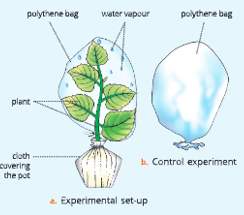
UP Board Notes For Class 10 Science Chapter 5 Transpiration Activity 2
To demonstrate transpiration in plants.
- You will require three bell jars and two cobalt chloride papers to perform this experiment.
- Take two similar-sized, well-watered potted
plants with broad leaves. Mark plants as A and B. - Now cover each plant with a bell jar. In the bell jar containing plant B place strips of dry cobalt chloride paper. Bell jar A Set up A
- Now you have two set-ups: Set-up A with a potted plant covered with a bell jar, and set-up B with a potted plant having strips of cobalt chloride paper and covered with a bell jar. Take another set-up C having bell jar with cobalt chloride paper but no plant. Seal the edges of each bell jar with vaseline that no air enters the apparatus from outside.
 Experiment demonstrating transpiration In plants. Note that bell jars A and B contain water vapour on the inner walls, the cobalt paper turns pink in bell jar B but there is no change in bell jar C
Experiment demonstrating transpiration In plants. Note that bell jars A and B contain water vapour on the inner walls, the cobalt paper turns pink in bell jar B but there is no change in bell jar C
Cobalt chloride paper acts as an indicator of moisture. It is blue when dry but becomes pink when exposed to moisture.
- Leave the three set-ups undisturbed under the sun for about one hour. Observe after one hour.
- The bell jar A shows water vapour condensed on its inner walls.
- The bell jar B shows water vapour condensed on the inner walls. The colour of cobalt paper turns pink in bell jar B.
- There is no condensation in bell jar C and no
change in the colour of cobalt chloride paper (i.e. it remains blue). This shows that there was no moisture in the bell jar C. - You may conclude that condensation of water vapour occurs and the colour of cobalt paper changes. These are the proofs of transpiration.
UP Board Notes For Class 10 Science Chapter 5 Transpiration How Is Water Made Available For Transpiration?
There is a continuous loss of water from the leaves by transpiration. The water lost from leaves is continuously replaced by more water which flows from leaf xylem vessels. Water flows from xylem vessels to the surface of mesophyll cells of the leaves by two routes.
- Imbibition: Most of the water flows directly through the porous cellulose walls of the mesophyll cells.
- Osmosis: A small amount of water flows by osmosis from cell to cell.
Flow of water up the xylem
As a result of transpiration, water pressure of the xylem vessels in leaves and stem becomes lower than that in the root xylem vessels. This pressure difference causes water to be sucked up from the roots into the leaves in a similar manner as we suck cold drink with a straw.
Flow of water from soil to root xylem
Water sucked up from roots to stem and leaves is replaced by water which flows from the soil through the freely permeable cellulose walls of root hair into the root cortex. This flow of water continues as long as a plant transpires.
Types of transpiration
On the basis of occurrence in different regions of a plant, transpiration is of three types:
1. Stomatal transpiration (from the leaves through the stomata)
2. Cuticular transpiration (from the waxy cuticle layer of leaves and stems)
3. Lenticular transpiration (from the lenticels present on the surface of old stems)
The maximum transpiration occurs through stomata on the leaves.
UP Board Notes For Class 10 Science Chapter 5 Transpiration Mechanism Of Stomatal Transpiration
Stomatal transpiration accounts for maximum (about 90%) transpiration in plants. Stomata are the minute openings present on one or both surfaces (epidermal layer) of the leaf. They facilitate exchange of gases between the leaf and the atmosphere. In stomatal transpiration, water vapour is lost through stomata in leaves.
The stomatal transpiration occurs as follows:
- Water is absorbed by root hair from the soil. This water then moves up through xylem vessels via stem into the spongy mesophyll cells of the leaves through veins.
- The spongy mesophyll cells in the leaves have large number of intercellular spaces. These cells give out some water as a thin film.
- The water from this thin film evaporates in the form of water vapour. The water vapour formed then saturates the air in the intercellular spaces.
- This water vapour then accumulates and reaches the substomatal space through various connecting intercellular spaces by diffusion.
- From substomatal spaces, the water vapour escapes from the stomata by the process of diffusion. The molecules of water move from the region of their higher concentration to the region of their lower concentration.
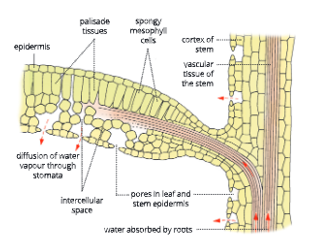
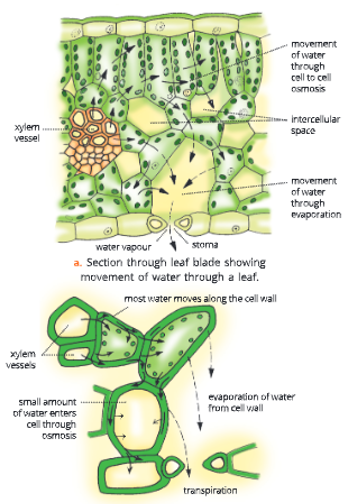
- The water from this thin film evaporates in the form of water vapour. The water vapour formed then saturates the air in the intercellular spaces.
- This water vapour then accumulates and reaches the substomatal space through various connecting intercellular spaces by diffusion.
- From substomatal spaces, the water vapour escapes from the stomata by the process of diffusion. The molecules of water move from the region of their higher concentration to the region of their lower concentration.
The water lost by cells is replaced by more water from the nearest xylem vessel. Most of the water moves along the cells by imbibition and only a small amount by osmosis.
UP Board Notes For Class 10 Science Chapter 5 Transpiration How Do Stomata Regulate Transpiration?
Stomata Regulate Transpiration As Follows
Stomata are minute openings found in the epidermis of leaves and stem. Each stoma contains a pore surrounded by two guard cells. Both guard cells are firmly joined at both ends but separate in the mid-region of their length.Stomata are present on the lower epidermis of the leaf in dicotyledonous plants.
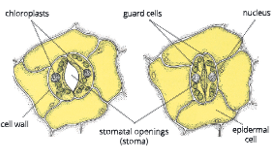
- The open stomata account for diffusion of water vapour through them. During the day, the cell-sap concentration becomes high due to the accumulation of sugar in the guard cells as a result of photosynthesis.
- In dicots, the lower surface of a leaf mainly has stomata. Therefore, more transpiration occurs from the undersurface (lower surface) of a leaf.
- This results in the movement of water into the guard cells from the neighbouring cells. This makes the guard cells turgid and guard cells bulge out and pull apart their inner walls and stomata open. If the availability
UP Board Notes For Class 10 Science Chapter 5 Transpiration Activity 3
To show that more transpiration occurs from the lower surface of a dicot leaf.
(Perform this activity on a relatively dry and non-cloudy day)
This activity should be performed on a dicot leaf. This is because dicot leaf has more stomata on the lower surface and very few on the upper surface.
- Take a well-watered, potted, dicot plant like balsam or china rose.
- Take two, 2 x 4 sq cm, pieces of cobalt chloride paper. Place one piece of cobalt chloride paper over a glass slide and hold it on the lower side of the leaf and place other paper on the upper side of the leaf in a similar manner (Fig. 5.6).
- Fasten both slides (beyond the margins of the leaf) with the help of gem clips. Observe for about1 hour.
Do not detach the leaf from the plant.
- The piece of cobalt chloride paper on the lower side of the leaf turns pink very fast. while the paper on upper surface remains same or takes a long time to turn pink. This shows that more transpiration occurs from the lower surface of the leaves of dicot plants because of the presence of more stomata.
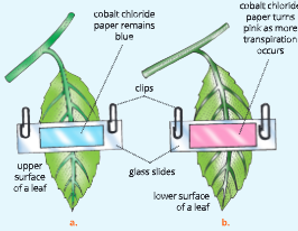
of water is reduced, the guard cells lose their turgidity and they become flaccid (lose turgidity) by exosmosis of water from them. This leads to the closing of stomata and transpiration stops.
Cuticular Transpiration
The cuticle is a waxy layer secreted by the epidermis of the leaves and young stems of the plant. Cuticular transpiration accounts for only 3-10% of the total transpiration. It continues throughout day and night.
There is very limited evaporation of water from the cuticle. The cuticular transpiration depends upon the thickness of cuticle. Greater the thickness of the cuticle, lesser is evaporation of water (lower cuticular transpiration) and vice versa.
Can you guess why desert plants have thick cuticle? They have thick cuticle to cut down the loss of water due to transpiration.
Lenticular Transpiration
It occurs in the woody branches of the trees where lenticels are found. Lenticels are special openings on the older stem in place of stomata.The lenticular transpiration accounts for only 0.1% of the total transpiration.
It continues day and night because lenticels do not close. Lenticels remain always open. In lenticular transpiration, water from the cell surface facing the lenticels evaporates directly.
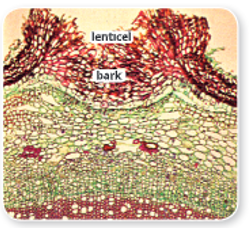
Measuring Rrate of Transpiration
There are mainly two methods for measuring the rate of transpiration:
- Weighing method
- Photometer method
1. Weighing method: In this method, a small lightweight potted plant is weighed before and after a certain period of time in which transpiration has taken place. The loss in weight by the plant during the time indicates the loss of water by transpiration. The following activity shows the measurement of transpiration by weighing method.
UP Board Notes For Class 10 Science Chapter 5 Transpiration Activity 4
To show the loss of water from leaves due to transpiration using weighing method.
1. Take a small potted plant and cover its soil surface with cloth also cover the pot with a polythene to prevent evaporation from the surface of the soil and pot. Weigh the pot at the start of the activity and after 2 hours. The difference in weight is the loss of water by plant due to transpiration.
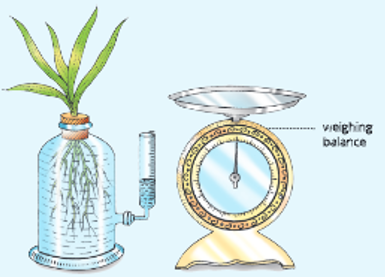
- Take a small plant and fix it in a glass bottle with a graduated side tube as shown in. Fill the bottle with water and note down its reading (water volume). Leave the set-up for 2 hours and observe. Check the level of water in the side tube at leafy the beginning and end of the shoot activity. You will observe that water level has come down. The loss in volume of water can be compared with the loss in weight of the plant with the tube help of a weighing balance.
- Take a leafy shoot (with no roots) and fix it in a test tube as shown in Figure 5.9. Fill
the test tube with water and pour some oil on the water surface so as to prevent any water evaporation. Place this test tube in a beaker and weigh the two together. Wait for 2 hours and weigh again. The difference in weight will indicate the loss of water by the shoot due to transpiration.

2. Potometer Method: Photometer (Gk. potos: drink, meter: measure) is a device that measures the rate of water intake by a plant (which is almost equal to the water lost by transpiration). There are mainly two types of potometers used in this method – Ganong’s potometer and Darwin’s photometer.
UP Board Notes For Class 10 Science Chapter 5 Transpiration Activity 5
To measure the volume of water uptake by plant during transpiration using potometer method.
Potometer such as Ganong’s potometer is a device made up of glass which is used to measure the rate of transpiration by a leafy shoot. To use the potometer, take a small twig of a plant like Plectranthus and cut the twig obliquely under water to allow larger surface for the water intake.
Fix the twig to one end of the potometer by using a rubber stopper or a cork as aper scopper shown in. Fill the apparatus with water, ensuring there are no air spaces in the set-up.
Introduce an air bubble into the horizontal graduated capillary tube by slightly lifting the tube and then dipping it in a beaker containing coloured water. As the shoot transpires, the water vapour lost is replaced by coloured water drawn in potometer which reaches into the xylem of the stem.
Similarly the air bubble also moves forward in the capillary tube. The reading in the capillary tube gives the volume of water lost in a given time.
Limitations
- It is very difficult to introduce air bubble in the
- The twig does not remain alive for a long time.
- Any change in the external temperature may affect the position of air bubble in the capillary tube.
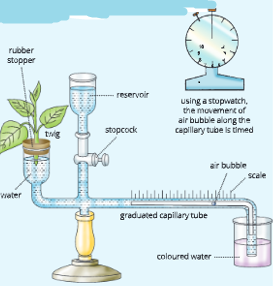
UP Board Notes For Class 10 Science Chapter 5 Transpiration Factors Affecting The Rate Of Transpiration
A. External Factors
1. Humidity (Vapour pressure): The humidity of the atmosphere affects the rate of diffusion of water vapour from the stomata. Low humidity in the atmosphere increases the rate of transpiration. On the other hand, high humidity in the air reduces the rate of outward diffusion of water from the sub-stomatal cavity and reduces the rate of transpiration, because the air is already laden with water vapour.
2. Temperature: High temperature increases rate of transpiration by providing the latent heat of vaporization. Rise in temperature increases evaporation of water while low temperature reduces evaporation.
3. Intensity of light: Light affects the rate of transpiration indirectly. More transpiration occurs during the day. Stomata open during light and thus transpiration occurs more in the day. During the night they are closed, thus the rate of transpirationis minimal. Can you guess what happens on a cloudy day?
4. Air movement (Velocity of wind): Moving air sweeps away the water vapour in the air outside the stomata. This speeds up the diffusion of water vapour from stomata. Thus, the rate of transpiration increases with the velocity of wind.
Some plants in dry conditions (xerophytes) have folded leaves or epidermal hair which help to retain moist air around the stomata to prevent transpiration.
5. Atmospheric Pressure: A decrease in atmospheric pressure increases diffusion of water vapour from stomata. The lower the atmospheric pressure, the greater is the rate of evaporation of water from leaves. Thus, the rate of transpiration increases with the decrease in atmospheric pressure.
6. Carbon dioxide concentration: If the increase in the concentration of carbon dioxide is more than the normal (0.03%), the stomata closes. This reduces the rate of transpiration.
7. Water supply to the leaf: Shortage of water in the soil affects the water supply to the leaf and in turn the stomata close and the leaf wilts. This reduces the rate of transpiration.
B. Internal Factor
1. Leaf Structure: The shape of the leaf and the number and position of stomata on it influence water vapour loss. In xerophytes, the cuticle is thick and there is negligible loss of water vapour (less transpiration). On the other hand, in the leaf of the shady plants which has a large surface area and a thin cuticle, the loss of water vapour is more (more transpiration).
UP Board Notes For Class 10 Science Chapter 5 Transpiration How Are Plants Adapted To Reduce Excessive Transpiration?
- The stomata may be sunken (deep seated) or covered by hair, as in oleander (Fig. 5.11).
- The number of stomata may be reduced as in xerophytes, like cactus.
- The leaves may become narrow to reduce leaf surface area, as in Nerium and pine.
- The leaves may roll over or fold to reduce exposed surface and maintain moisture around the stomata, as in desert grass.
- There may be very few leaves on a plant to reduce transpiration, such as in Acacia.
- The leaves may have thick cuticle, as in mango, banyan and most evergreen trees to prevent transpiration.
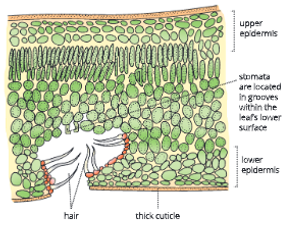
Significance of Transpiration
Ascent of Sap
Transpiration helps in the ascent of sap due to a suction force or pull created by the loss of water. As water evaporates from leaves, a suction force is developed at the top of the plant, which draws more water from the soil through roots and stems.
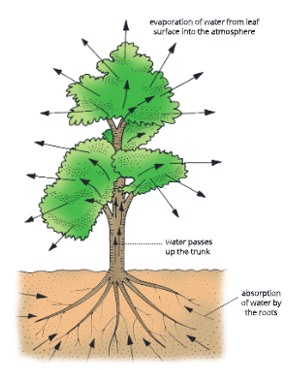
Removal of Excess Water
Plants absorb far more amount of water than is actually required by them. Thus, transpiration helps in removing excess of water.
Cooling Effect
Solar heat during summers increases the temperature of plants, which may be dangerous to the plants. Transpiration helps in reducing the temperature of the leaf surface by evaporation of water vapour from it, which in turn cools the plant.
Distribution of Mineral Salts
The transpiration from leaf surface draws more water from the lower parts and in turn from the soil. This rising column of sap from the soil contains mineral salts. Thus, the mineral salts are distributed to all parts of the plants.
Guttation and Bleeding
Guttation (L. gutta: drop): You must have seen accumulation of water droplets on the surface of leaves in some plants, early in the morning. This is due to guttation. Guttation is exudation of water droplets on the leaf margins of plants such as banana, growing especially in warm humid conditions.
The loss of water in the form of droplets from the margins of the leaves of certain plants during hot and humid conditions is known guttation or exudation It is caused due to root pressure.
When the rate of transpiration is low, the roots of some plants keep accumulating minerals and absorbing water. Thus, more water enters the leaves than is transpired. As a result, the excess water is forced out through specialized structures on the margins of the leaves called hydathodes.
The differences between guttation and transpiration is given in Table .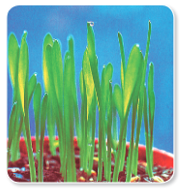
Bleeding: During injury to certain plant tissues, the plant sap escapes (bleeds) from the ruptured or cut surface of the plant. This is brought about by the rootpressure generated by the plant.
UP Board Notes For Class 10 Science Chapter 5 Transpiration Summary
- The loss of water as water vapour from the aerial parts of the plant is called transpiration. Transpiration is different from evaporation.
- Transpiration produces a suction force which draws water up from the soil to the leaves.
- There are three types of transpiration – stomatal, cuticular and lenticular transpiration.
- Stomatal transpiration occurs by diffusion of water vapour through stomata and accounts for maximum transpiration by a plant.
- Cuticular transpiration involves the loss of water vapour from the surface of leaves and young stems of the plant. It occurs throughout the day and night.
- Lenticular transpiration occurs through lenticels found in the woody branches of trees. It occurs continuously.
- Transpiration rate can be measured by weighing method or with the help of a potometer.
- Rate of transpiration increases with an increase in the intensity of light, temperature, velocity of wind and availability of water. High humidity in the air reduces the rate of transpiration.
- There are many advantages of transpiration for a plant such as cooling, ascent of sap, distribution of minerals and removal of excess water.
- Guttation is loss of water from the leaf margins of plants in the form of droplets.

